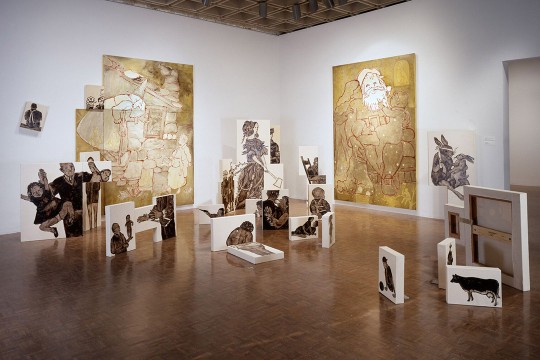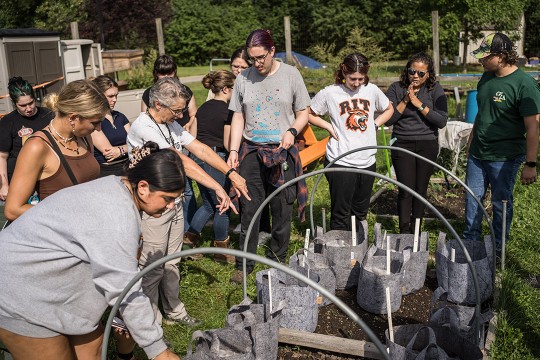
Ellen Tani
Assistant Professor, Art - History
Ellen Tani
Assistant Professor, Art - History
Bio
Ellen Y. Tani is an art historian and curator who explores the histories of American art and global contemporary art through a critical race studies lens, with a particular focus on conceptual- and performance-oriented practices. Her research examines how contemporary artists work to illuminate structures of exploitation and inequality that operate below and beyond the threshold of visibility. It has been supported by the Carter G. Woodson Institute for African and African American Studies at the University of Virginia, the Center for Comparative Studies in Race and Ethnicity at Stanford University, the Clark Art Institute, the Getty Research Institute, the Smithsonian American Art Museum, and the Center for Advanced Study in the Visual Arts. She has worked as a curator at the ICA/Boston, the Bowdoin College Museum of Art, and independently, and brings an artist-centric practice to her scholarship. Her writing has appeared in exhibition catalogs, edited volumes and peer-reviewed publications, including Art Journal, ASAP Journal, American Quarterly, and Panorama. Her current book project examines the career of conceptual artist Charles Gaines (MFA ‘67, Dr. h.c. ’23).
Select Scholarship
Peer-Reviewed Journal Articles and Book Chapters
"On the Edge: The Theater of Refusal (Black Art and Mainstream Criticism)" ASAP/Journal, Johns Hopkins University Press, Volume 9, Number 2 (May 2024) pp. 235-267.
“Un-Disciplining the Archive: Jerome Reyes and Maia Cruz Palileo.” Panorama: Journal of the Association of Historians of American Art, Issue 7.1 “Asian American Art: Past and Futures” (Spring 2021).
“’Very African, and Very Kabuki Too’: Transnational Ritual in the work of Senga Nengudi.” Transnational Perspectives on Feminism and Art, 1960-1985. Ed. Jen Kennedy, Trista Mallory, and Angelique Szymanek (London; New York: Routledge, 2021),169-184.
“’Come Out to Show Them’: Speech and Ambivalence in the work of Steve Reich and Glenn Ligon.” Art Journal Volume 78, Issue 4, 2019.
“Paul Pfeiffer,” Apricota Journal, Issue 1: Fights (Fall 2017): 88-93.
“Keeping Time in the Hands of Betye Saar: ‘Betye Saar: Still Tickin’” American Quarterly v. 68, no. 4 (December 2016): 1081-1109.
Selected Essays and Reviews
"Best Show 2024: Nikita Gale." Artforum v.63, no.4, December 2024.
"Interview: Charles Gaines by Ellen Tani" BOMB, Spring 2024.
"Review: Death's Futurity: The Visual Life of Black Power." caa.reviews, October 23, 2024.
“Pressing Against Looking: Gina Osterloh in the Mind of the Camera.” Gina Osterloh: Mirror Shadow Shape, Columbus Museum of Art, 2023.
“Review: Stephanie Sparling Williams, Speaking Out of Turn: Lorraine O'Grady and the Art of Language.” caa.reviews, March 25, 2022.
“Review: Celeste-Marie Bernier, Stick to the Skin: African American and Black British Art, 1965–2015.” Panorama: Journal of the Association of Historians of American Art, Issue 6.2, November 2020.
“What You Missed: Senga Nengudi’s Performed Objects.” Senga Nengudi (New York: Dominique Levy Gallery, 2015): 18-23.
“The Face is a Politics.” Charles Gaines: Gridwork 1974-1989 (New York: The Studio Museum in Harlem, 2014): 57-63.
Recent Exhibitions
RETRO/action, co-curated with Kate Fowle, Homi Bhabha, and Charles Gaines. Hauser & Wirth 69th Street (Nov 15, 2023 - Jan 27, 2024) and Hauser & Wirth Los Angeles (Feb 23 - May 5, 2024).
Currently Teaching
In the News
-
December 27, 2023

Two Watershed Shows About 1993 Help Make Sense of 2023
The New York Times features Ellen Tani, assistant professor of art history, who co-curated the exhibition “RETROaction” with artist Charles Gaines ’67 MFA (art and design).
-
September 15, 2023

Students are studying gardening, pirates, and art ‘younger than the internet’ in the classroom this fall
Gardening, piracy, and contemporary art are just three of the varied topics students will delve into over this semester as part of RIT’s General Education curriculum.
-
August 30, 2023

New School of Design director, faculty hires ready for 2023-24 academic year
The College of Art and Design welcomes new hires to its faculty roster while longtime faculty Alex Lobos assumes a role as director of the School of Design.
-
December 21, 2023
Tani co-curates exhibition with Charles Gaines



